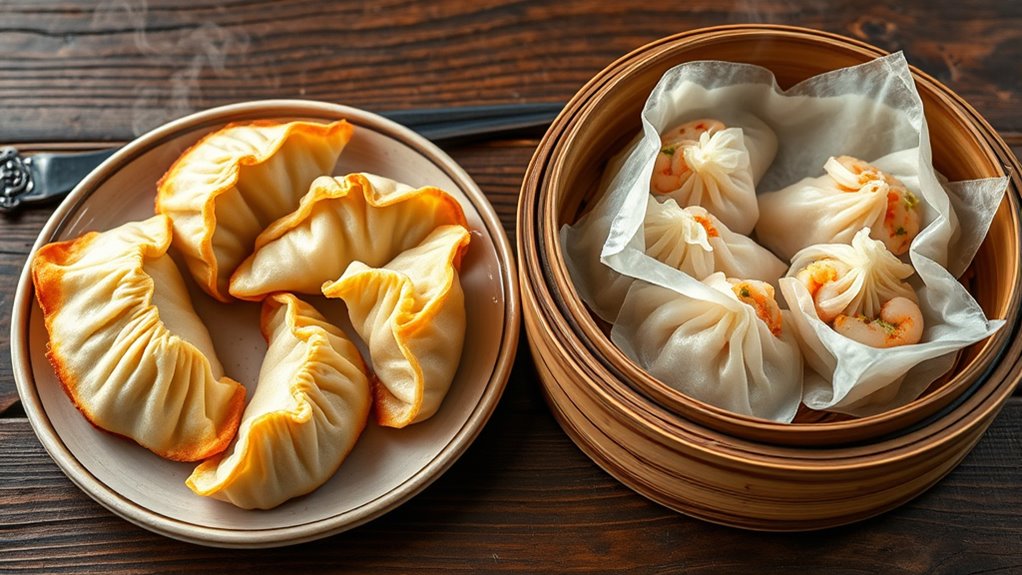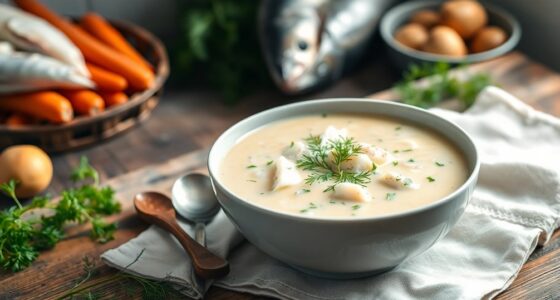Regional Chinese dumplings differ greatly between North and South regions. North dumplings, like Jiaozi, typically feature hearty fillings such as pork and cabbage, with thick wrappers, and are often boiled or steamed. South varieties, like Wontons, tend to be lighter with seafood or shrimp, served in broths, or fried for crispness. These differences reflect regional flavors, cooking styles, and cultural customs. If you explore further, you’ll discover how these traditions shape each unique dumpling experience.
Key Takeaways
- North Chinese dumplings (Jiaozi) are heartier, often boiled or steamed, with thick wrappers and fillings like pork and cabbage.
- South Chinese dumplings (Wontons) are lighter, typically pan-fried or boiled, with delicate wrappers and seafood or shrimp fillings.
- North dishes emphasize bold, savory flavors with spices like chili oil, while South favors fragrant herbs like cilantro and ginger.
- North dumplings are often served steamed or fried for a chewy texture; South dumplings are usually served in broth or with dipping sauces.
- Cultural significance varies: North dumplings symbolize unity during Lunar New Year; South dumplings connect to family and historical traditions.
Key Ingredients and Fillings
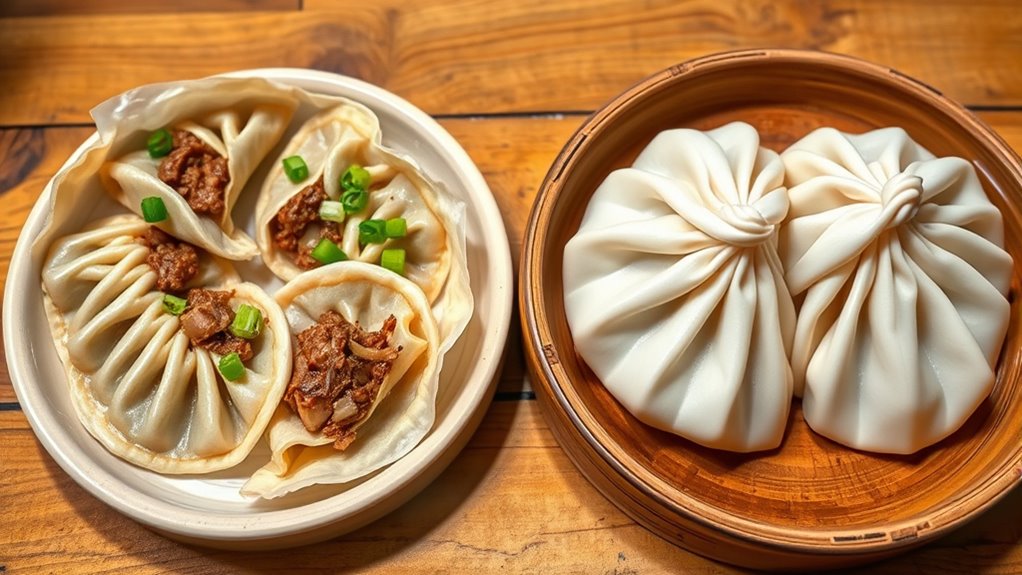
When it comes to making regional Chinese dumplings, selecting the right ingredients is essential. You’ll want to choose fresh, high-quality components to guarantee authentic flavors. For the wrappers, use wheat flour and water, kneading until smooth. For fillings, the ingredients vary by region. In the North, you’ll often find fillings with ground pork, cabbage, and scallions. In the South, seafood, shrimp, or chicken are common, sometimes combined with vegetables like bok choy or mushrooms. Seasonings such as soy sauce, ginger, garlic, and sesame oil add depth to your fillings. You can also customize fillings to your taste, balancing moisture and flavor. Remember, the freshness and quality of ingredients are key to making delicious regional Chinese dumplings. Additionally, understanding the building process of traditional dumplings can help you achieve the perfect texture and flavor.
Traditional Cooking Techniques

You’ll notice that different regions use unique dough preparation methods, which affect the dumplings’ texture. Filling variations bring distinct flavors and ingredients to each style, highlighting local tastes. Cooking and serving styles, like steaming, boiling, or pan-frying, also shape the final experience. Additionally, understanding Relationship Dynamics can enhance shared meals by fostering open dialogue and mutual appreciation during traditional cooking and dining experiences. Recognizing the Regional Culinary Heritage of each style enriches the cultural significance and authenticity of the dishes. Incorporating cultural authenticity into preparation techniques further emphasizes regional identity and tradition. Exploring creative expression within traditional methods can inspire modern twists that celebrate regional diversity while honoring heritage. The use of dough techniques directly influences the final texture and mouthfeel of the dumplings, making regional methods an essential aspect of authenticity.
Dough Preparation Methods
To achieve the perfect dumpling wrapper, traditional Chinese dough preparation methods emphasize careful mixing and kneading. You start by combining flour and water, then knead the dough until it’s smooth and elastic. Proper kneading develops gluten, giving the wrapper strength and flexibility. Here are key steps:
- Use the right flour – typically high-gluten or all-purpose flour for better elasticity.
- Control the water amount – gradually add water to avoid a sticky or dry dough.
- Knead thoroughly – work the dough for at least 10 minutes for ideal texture.
- Rest the dough – cover and let it sit for 30 minutes to relax the gluten, ensuring easier rolling.
Following these steps guarantees a sturdy, tender wrapper perfect for folding and cooking.
Filling Variations and Flavors
Traditional cooking techniques bring out the rich diversity of dumpling fillings and flavors, allowing you to customize each bite. North and South China use different ingredients and seasoning styles, creating unique tastes. In the North, you often find hearty pork, cabbage, and scallions packed into thick wrappers. In the South, lighter fillings like shrimp, fish, or vegetables are common. To enhance flavors, cooks use seasonings like soy sauce, ginger, garlic, and sesame oil, blending them skillfully for depth. Consider this table:
| Filling Type | Common Ingredients |
|---|---|
| Pork-Based | Pork, cabbage, scallions |
| Seafood | Shrimp, fish, ginger |
| Vegetables | Napa cabbage, mushrooms |
| Beef | Ground beef, onions |
| Vegetarian | Tofu, spinach, mushrooms |
These variations let you tailor each dumpling to your taste, highlighting regional preferences and techniques. Understanding regional differences enhances appreciation of traditional cooking styles.
Cooking and Serving Styles
Cooking dumplings using traditional techniques imparts distinct textures and flavors that define regional styles. North Chinese dumplings are often boiled or steamed, resulting in tender, juicy bites perfect for quick, healthy meals. South Chinese dumplings, on the other hand, are usually pan-fried or deep-fried, creating crispy, golden edges that add extra crunch. To prepare them authentically, you might:
- Boil or steam dumplings in large pots for a soft, delicate texture.
- Pan-fry until bottoms are crispy, then add water to steam the tops—classic “potstickers.”
- Deep-fry for a crunchy exterior, popular in southern regions.
- Serve immediately with dipping sauces, emphasizing regional flavor preferences.
These methods highlight regional preferences, giving each style its unique taste and presentation.
Regional Flavors and Seasonings
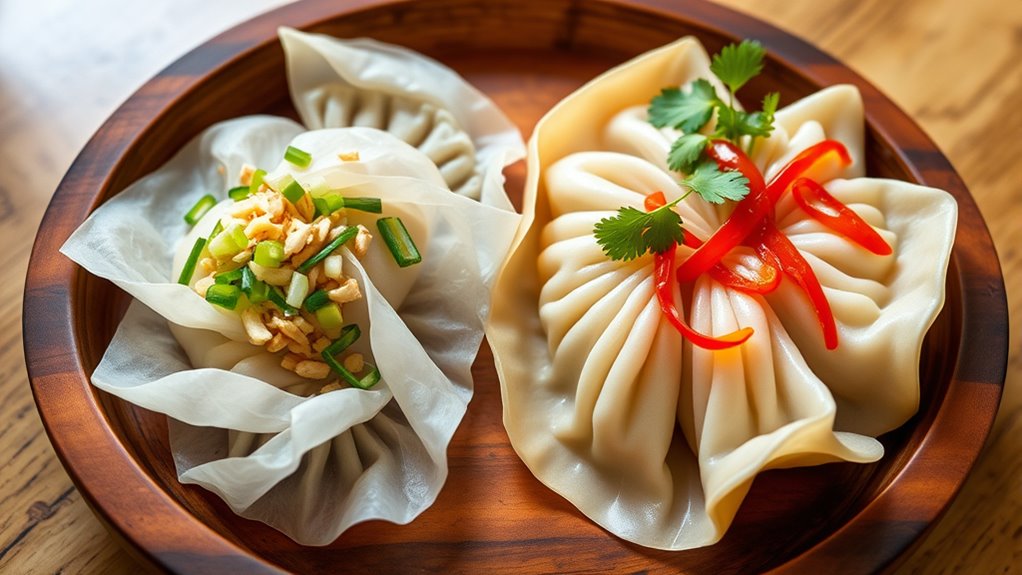
In northern China, dumplings are packed with bold, savory spices that create a hearty flavor. Meanwhile, southern varieties often feature fragrant, aromatic herbs that add a delicate, fresh taste. Understanding these regional seasonings helps you appreciate the unique character of each dumpling style. air purification technology plays a role in maintaining freshness and removing odors during the cooking process. Additionally, organized kitchen spaces can facilitate efficient preparation and help manage ingredients for different regional styles.
North: Bold, Savory Spices
Northern Chinese dumplings are distinguished by their bold, savory spices that enhance each bite. You’ll notice strong flavors that pack a punch, giving the dumplings a hearty, satisfying taste. These spices often include ingredients like garlic, ginger, scallions, and soy sauce, which create a rich flavor profile. To deepen the savory notes, chefs sometimes add chili oil or fermented bean paste, adding warmth and complexity. Here’s what makes them stand out:
- Garlic and ginger for a pungent, aromatic base
- Soy sauce for umami depth
- Chili oil for a spicy kick
- Fermented bean paste for a savory, tangy undertone
These bold seasonings define the robust character of northern dumplings.
South: Fragrant, Aromatic Herbs
Have you ever noticed how southern Chinese dumplings burst with fresh, fragrant aromas? That’s thanks to the generous use of herbs like cilantro, green onions, and basil. These herbs add a bright, lively scent that elevates each bite. You’ll often find ginger and garlic incorporated into the filling, providing warmth and depth. Unlike the bold spice blends of the north, southern dumplings focus on aromatic herbs that create a delicate, enticing fragrance. The seasonings are usually lighter, emphasizing freshness and natural flavors. This herbal approach results in dumplings that smell as delightful as they taste, making every bite feel vibrant and inviting. When you dine on southern dumplings, you’re savoring a symphony of fragrant herbs crafted to awaken your senses. Attention to the use of herbs enhances the overall sensory experience of these regional flavors, showcasing the importance of regional flavor profiles in Chinese cuisine. Additionally, incorporating high-quality fresh ingredients ensures the herbs retain their aromatic potency, elevating the dish’s overall appeal. Furthermore, using medicinal herbs can add subtle health benefits and deepen the flavor profile of the fillings. Incorporating sustainable sourcing of herbs can also support eco-friendly practices and ensure freshness.
Popular Dishes From the North and South
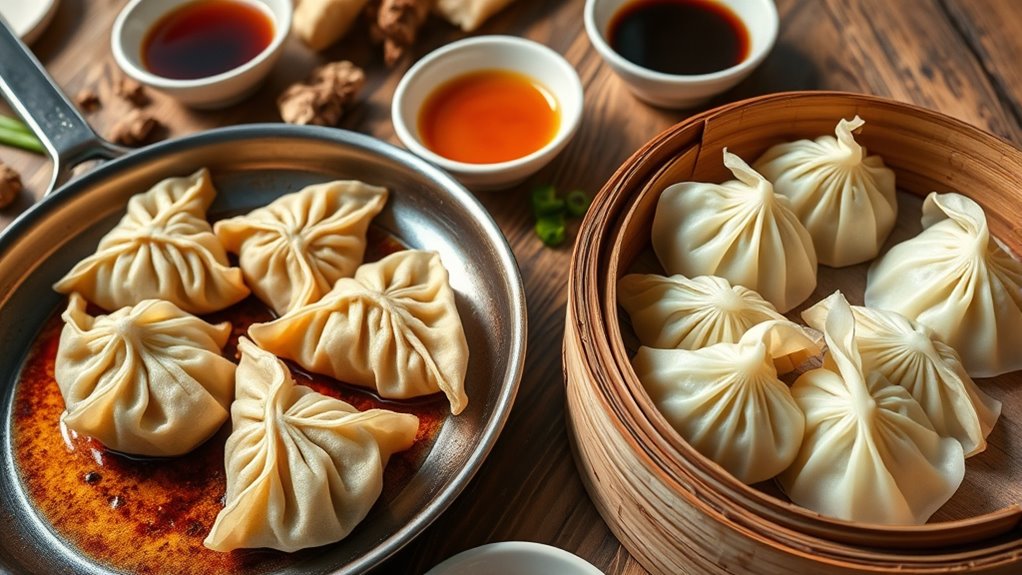
Different regions of China boast distinct styles of dumplings that reflect their unique culinary traditions. In the North, you’ll find hearty, thick-skinned dumplings like Jiaozi, often filled with pork and cabbage, served boiled or pan-fried. In the South, lighter, more delicate dumplings are popular, such as Wontons, typically filled with shrimp or pork and served in broth. Here are some popular dishes from each region:
- Northern Jiaozi – steamed or fried, often enjoyed with soy sauce.
- Southern Wontons – served in clear broth or with dipping sauce.
- Beijing Mongolian Dumplings – known for their juicy fillings.
- Guangdong Shrimp Dumplings – delicate, steamed, with translucent wrappers.
These dishes highlight the diversity and regional flavors across China.
Cultural Significance and Customs

Dumplings hold a special place in Chinese culture, symbolizing unity, prosperity, and family bonds. During festivals like Lunar New Year, families gather to make and share dumplings, reinforcing connections and tradition. In northern China, making dumplings is often a communal activity, passed down through generations, emphasizing respect for heritage. In southern regions, dumplings may be linked to specific customs, such as celebrating milestones or honoring ancestors. The act of preparing and eating dumplings reflects values of harmony, togetherness, and good fortune. These customs highlight how dumplings serve as more than just food—they are cultural symbols that bring families and communities closer, reinforcing identity and shared history across Chinese society. Embracing minimalist traditions in presentation and celebration can enhance the appreciation of these rich customs, especially when incorporating traditional techniques that have been preserved over centuries. Recognizing the importance of cultural symbolism helps deepen the understanding of these customs and their significance in contemporary society. Additionally, the regional variations in dumpling preparation further showcase the diversity of Chinese culinary heritage, illustrating how local ingredients and methods influence regional flavors and styles.
Eating Etiquette and Traditions
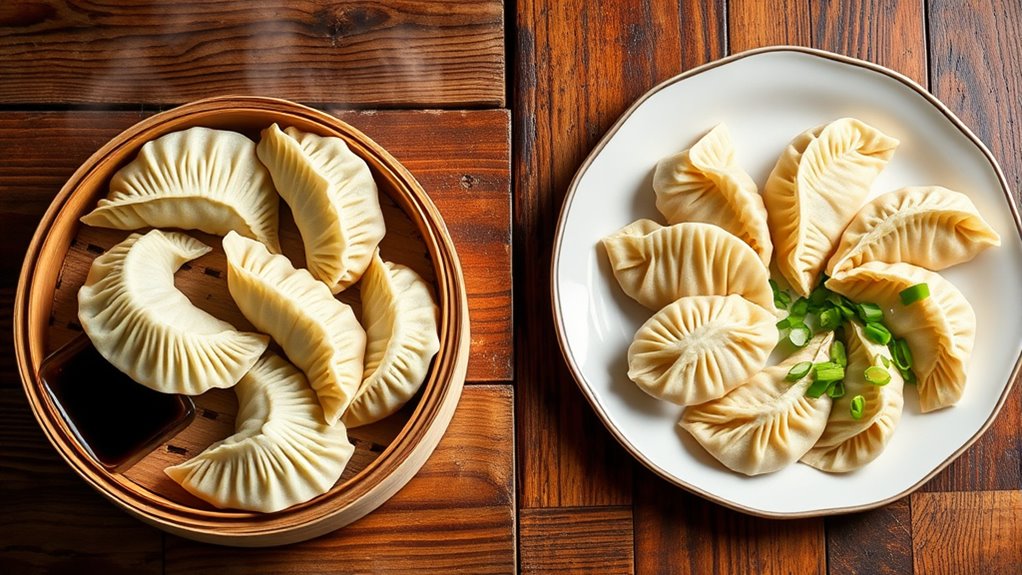
When enjoying dumplings in China, observing proper eating etiquette enhances the experience and shows respect for tradition. Your manners matter, whether you’re in the North or South. Here are some key customs to keep in mind:
- Use chopsticks properly, avoiding sticking them upright into the dumplings, as it resembles offering incense at funerals.
- Wait for the host or elders to start eating before you join in.
- Dip dumplings lightly in soy sauce or vinegar, but don’t overdo it—excess dipping is considered impolite.
- When sharing, take small portions from communal plates to show respect and maintain cleanliness.
- Paying attention to dining etiquette helps deepen your understanding of Chinese cultural traditions and fosters respectful interactions. Remember that cultural customs can vary slightly between regions, so observing local practices is always appreciated. Additionally, being aware of social norms related to food sharing can enhance harmony at the table. Being mindful of regional differences in dining practices demonstrates cultural sensitivity and enriches your dining experience. Furthermore, understanding the home essentials involved in traditional Chinese dining can improve both your comfort and etiquette during meals.
Modern Interpretations and Fusion Styles
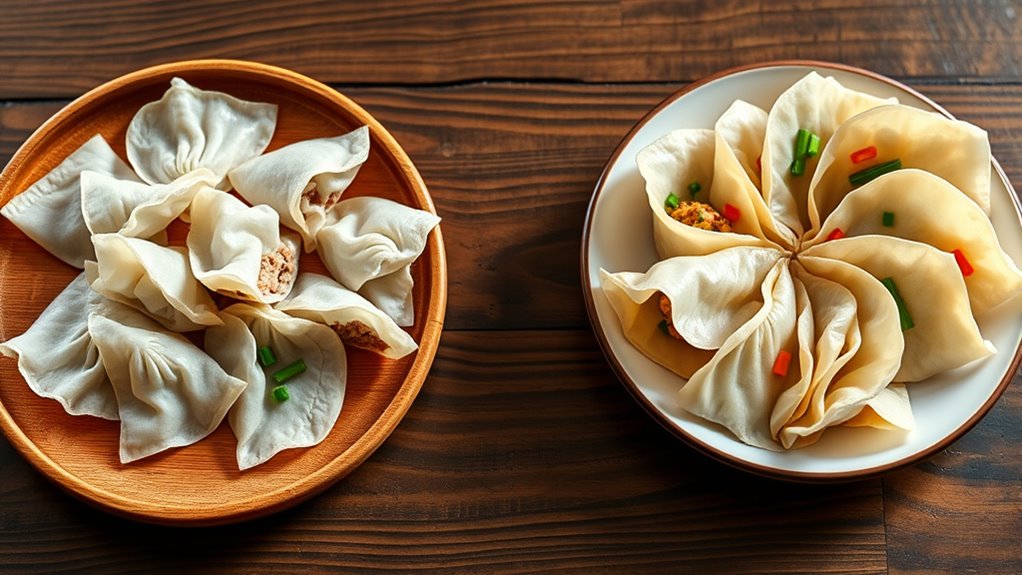
As modern chefs and food enthusiasts experiment with traditional recipes, dumplings have become a canvas for innovative flavors and presentations. You’ll find fusion styles that blend Chinese techniques with global ingredients, such as sushi-inspired dumplings or spicy kimchi fillings. Chefs also play with shapes, creating visually striking versions that appeal to contemporary tastes. Some incorporate unexpected elements like cheese, herbs, or even sweet fillings, moving beyond classic savory profiles. These modern interpretations challenge traditional boundaries, making dumplings more versatile and accessible. Whether served as tapas, street food, or upscale dishes, fusion dumplings invite you to explore new flavor combinations. This evolution reflects cultural exchange and a desire to reinvent a beloved staple, keeping dumplings relevant in today’s diverse culinary landscape.
Frequently Asked Questions
How Do Regional Differences Influence Dumpling Presentation and Serving Styles?
Regional differences greatly influence how you see dumplings presented and served. In the north, you’ll find dumplings with thicker wrappers, often boiled or steamed, served simply with dipping sauces or soups. In the south, dumplings tend to be lighter, with delicate wrappers, and are often pan-fried or served in soups with vibrant fillings. These style variations reflect local ingredients, culinary traditions, and dining customs, shaping your dumpling experience across China.
Are There Specific Festivals Dedicated to Dumplings in Northern or Southern China?
Ever wonder if there’s a special occasion just for dumplings? In northern China, the Dragon Boat Festival often features dumpling feasts, celebrating tradition and family. Meanwhile, southern regions may not have a dedicated dumpling festival, but they cherish dumplings during Lunar New Year and local celebrations. These festivals highlight how regional customs shape when and how you enjoy dumplings, making each bite part of a bigger story.
How Do Regional Chinese Dumplings Vary in Their Nutritional Content?
You’ll find regional Chinese dumplings vary in nutritional content based on ingredients and preparation methods. Northern dumplings often have more wheat flour, making them higher in carbs, while southern versions may incorporate more vegetables or seafood, boosting vitamins and minerals. If you choose steamed dumplings, you get fewer calories than fried ones. Overall, regional differences influence the balance of carbs, proteins, and fats, giving each style its unique nutritional profile.
What Are Common Dipping Sauces Paired With North and South Chinese Dumplings?
When you enjoy Chinese dumplings, you’ll find that dipping sauces enhance their flavors. For North-style dumplings, you often dip them in soy sauce with vinegar and ginger, adding a savory tang. South-style dumplings are commonly paired with spicy chili oil, soy sauce, or a mixture of soy and vinegar. These sauces complement the regional flavors, making each bite more delicious and authentic to the local taste.
How Have Regional Chinese Dumplings Evolved With Modern Dietary Trends?
Imagine your taste buds dancing as modern dietary trends reshape traditional dumplings. You’ll notice healthier fillings like vegetables, lean meats, and gluten-free wrappers emerging, giving classic dishes a fresh twist. You might also find innovative flavors and fusion styles blending global influences. These changes let you enjoy comforting bites without compromising health, making each dumpling a delightful balance of tradition and contemporary wellness, inviting you to savor tradition with a modern twist.
Conclusion
Whether you prefer the hearty, savory flavors of northern dumplings or the delicate, nuanced tastes of the south, each style tells a unique story. Exploring these regional differences is like taking a journey through China’s diverse landscape—each turn offers new surprises. Embrace both, and you’ll see that dumplings aren’t just food; they’re a bridge connecting tradition, culture, and family. Just like a good dumpling, they bring warmth and togetherness wherever you go.
